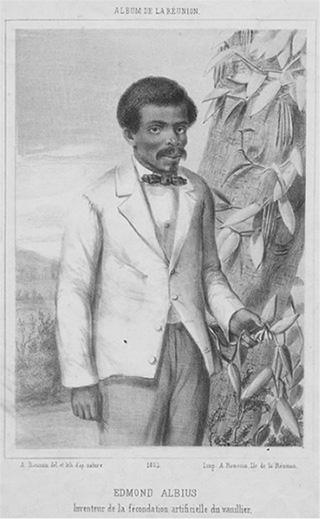
Situated in the Indian Ocean, the island of La Réunion is the birthplace of global vanilla production.
The chocolate brown pods of Vanille de l’île La Réunion PGI boast an intense scent and sweet taste which is prized by chefs around the world.
Origins
Native to Central America, vanilla was first exported to Europe by Spanish conquistadors in 1721. The aristocratic and royal classes of Europe were captivated by the delicate aroma of this exotic spice and for the next hundred years, there were many unsuccessful attempts to cultivate the plant in large quantities on European soil. In 1821, vanilla planifolia from the botanical gardens of Paris was introduced to La Réunion, where it grew successfully.
Pollination of the plant is required to produce the fruit from which the vanilla spice is obtained. In Central America, this was done by a small, stingless Melipona bee, native to the region. No insect or bird capable of pollinating the vanilla plant was to be found on La Réunion and so, for 20 years, the vanilla planted on the island remained infertile.
This changed in 1841 when Edmond Albius, a 12 year old slave and botany enthusiast, discovered a technique to pollinate the vanilla plant by hand. Albius found that by using a stick to lift up the wall separating the plant’s male and female organs and rubbing them together gently, fertilisation occurred. This meant a method had finally been found to produce vanilla quickly and profitably around the world.
Almost all vanilla is still pollinated using Albius’ method today. The production of vanilla has played such an important role in the economy of La Réunion throughout history that a vanilla vine features prominently on the territory’s coat of arms, which were designed by Governor Émile Merwart in 1925.
Vanille de l’île de La Réunion’s world-renowned reputation stems from its unique aromatic signature, which is the result of the natural conditions in which it grows and the expertise of those that produce it. In recognition of this, it was designated a protected geographical indication (PGI) in 2021.
Production
The cultivation and processing of Vanille de l’île de La Réunion PGI must take place in the municipalities of Bras-Panon, Saint-André, Saint-Benoit, Saint-Joseph, Saint-Philippe, Sainte-Marie, Sainte-Rose and Sainte-Suzanne, all of which are located in the eastern part of the island.
At both the cultivation and processing stages, the mild and humid weather conditions on the island’s ‘windy coast’ promote the aromatic compound precursors of the vanilla pods, ensuring the development of its sweet scent and taste.
The island of La Réunion is where expertise in the production of vanilla originated. In addition to the manual pollination technique, processing the vanilla by mortification (or ‘killing’) and steaming was developed and perfected there. While these processes are now replicated around the world, the methods developed by the island’s producers serve as a guarantee of the quality of Vanille de l’île de La Réunion PGI.
After cultivation, the processing stage is designed to bring out the full taste of the vanilla pods. They are dried in the sun and then the shade for a minimum of 20 days, before being placed in closed wooden boxes to age for at least seven months. This ensures the final product contains no lingering taste of creosote or tar that is often found in other types of vanilla that are dried too quickly and matured in vacuum bags – a process known as anaerobic fermentation.
Vanille de l’île de La Réunion PGI is sold in three different forms.
- Dried vanilla pods that are malleable, with a glossy sheen, ranging in colour from brown to dark chocolate brown.
- Fresh vanilla pods that are fleshy, glossy and a uniform reddish brown colour. These pods are stiff to the touch and cannot be bent.
- Crystallised vanilla which is formed naturally on the pods during the ageing process, shaped like stars, needles or grains of sugar. This form has the most intense and subtle scent, making it highly sought after and appreciated in culinary arts.
Vanille de l’île de La Réunion PGI is celebrated around the world for its exceptional qualities, and has been publicly lauded on many occasions by various Michelin star chefs, including Guy Martin, Alain Passard, Pierre Hermé and Jacques Genin.
More information
Vanille de l’île de La Réunion PGI – legal specifications



